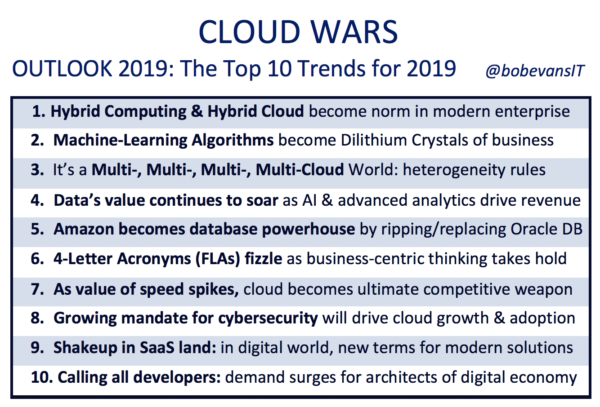If you have any doubt—any doubt whatsoever—that the enterprise cloud has not just arrived but has moved to center stage, consider this: for calendar 2018, the revenue of just the four largest cloud vendors will almost certainly exceed $90 billion. (My projections: Microsoft $32 billion, Amazon $26 billion, IBM $19 billion, and Salesforce $13 billion for a conservative four-vendor total of $90 billion.)
We’re seeing leaders across almost every industry move mission-critical workloads to the cloud, as aggressive adoption of cloud databases, apps and infrastructure becomes commonplace in companies of every size and in every corner of the world.
And we’re seeing very clearly that it’s no longer just LOB leaders and CIOs pushing the cloud agenda: CFOs, CMOs, CHROs and a surging number of CEOs are becoming fervent evangelists of the cloud’s ability to accelerate business operations, form the ideal platform for end-to-end digitalization, and allow businesses to focus more time, energy and resources on dazzling their customers.
On top of that, the cloud is hypercharging small and mid-sized businesses by giving them access to the same types of incredibly powerful and easy-to-use modern technology that the world’s biggest corporations use.
Taken together, these forces and rapidly changing business norms are producing waves of innovation in a global economy that’s increasingly focused on delivering the digital lifestyles that billions of people around the globe are pursuing and embracing.
And—to paraphrase Julius Caesar, we ain’t seen nuthin’ yet!
2019 will make this past year seem like a sleepy vacation. Here are my Top 10 picks for the biggest ways in which the cloud—the engine of the global digital economy—will rev things up even further.

1. The Hybrid Cloud Becomes The Norm.
This has nothing to do with any special code being cooked up the labs of software vendors, and everything to do with the way business customers want to consume cloud technology and transform into the digital enterprises they need to become. Businesses want to be able to pick and choose how and where they blend cloud services with their established on-premises systems, and vendors that don’t recognize that will become increasingly irrelevant in 2019.
2. Machine-Learning Algorithms: The Dilithium Crystals of the Cloud.
AI in all of its many forms is making an incredible impact on business; in our increasingly digitally dense and automated world, machine-learning algorithms are helping businesses optimize decision-making and outcomes in a sweeping range of areas, including better decisions in surgical procedures, more-precise predictions of consumer behavior, and more-accurate financial closings.
3. It’s a Multi-, Multi-, Multi-, Multi-Cloud World.
Just as business executives want to weave cloud services and on-premises systems in ways that drive optimal value, so too are they not just willing but eager to deploy cloud services and technologies from multiple vendors. So every cloud vendor had better redouble its efforts in 2019 to meet the unflinching needs of today’s multi-cloud world.
4. Data’s Value Continues to Soar.
And no, data’s not “the new oil”—oil can generally be used only once, whereas data only gets better with multiple uses, particularly with the emergence of increasingly sophisticated analytical and predictive tools in the cloud. C-level execs will shell out billions of dollars in 2019 to cloud vendors that can help them turn data into inexhaustible fuel for driving revenue growth, customer intimacy, and enterprise-wide innovation.
5. Amazon Rips Out Oracle Database and Disrupts a Massive Business.
Larry Ellison has issued some classic taunts at Amazon over the years, lampooning its rival for using the market-leading Oracle Database to run its business rather than using Amazon’s own home-growth databases. But that’s begun to change dramatically, as Amazon has committed publicly to being completely off Oracle Database technology by the end of 2019, and perhaps sooner. It is impossible to overstate the impact this will have on the enterprise-tech business.
6. Four-Letter Acronyms Lose Favor as Customer-Centric Thinking Takes Hold.
I know, I know, it’s hard to think about customers when your code is so great. But business customers are getting tired of the tech-centric marketing and sales approaches of many cloud vendors, and so I believe 2019 will see many of those vendors reframe their products, services and value less so around what their stuff is, and more so around what that wondrous stuff will do for the businesses who buy it.
7. As Time Becomes the Ultimate Competitive Weapon, Cloud Is the Ultimate Accelerator.
Consumers want exactly what they want when they want it, how they want it, and where they want it—and that presents an range of wildly difficult challenges for the businesses serving those consumers. The cloud can be the great accelerator, and in the coming year we’ll see businesses not just expect but demand that cloud vendors articulate clearly how their services give the gift of speed.
8. The Growing Mandate for Cybersecurity Will Drive Cloud Growth and Adoption.
As cybercrime grows worse, executives will come to see that the world’s leading cloud vendors can do a better job at cybersecurity than those businesses can, no matter how talented and committed they might be. The threats are becoming maddeningly sophisticated and relentless, and the cloud will be seen as the last best solution.
9. Shakeup in the SaaS World: Fresh Thinking for the Digital Economy.
SAP—the company that created the automated enterprise software business—has spent the past year turning that same software world upside-down. Early this year, it made a big public declaration about reimagining and rebuilding the CRM business, and just last month made a bold bid to interconnect the supply chain and the demand chain. We will see more such bold moves from the SaaS business in 2019 as the focus shifts away from enterprise efficiency to customer-centric digital business.
10. Developer Power.
Earlier this year, Microsoft CEO Satya Nadella said that data from LinkedIn revealed that for the first time, non-tech businesses were hiring more developers than tech businesses were. As digital business becomes a truly end-to-end proposition in 2019, with every department and functional area continuing to become increasingly dependent on data and digital tools, Nadella’s image of “tech intensity” will become a primary source of competitive advantage.
Subscribe to the Cloud Wars Newsletter for twice-monthly in-depth analysis of the major cloud vendors from the perspective of business customers. It’s free, it’s exclusive, and it’s great!
*******************
RECOMMENDED READING FROM CLOUD WARS:
The World’s Top 5 Cloud-Computing Suppliers: #1 Microsoft, #2 Amazon, #3 Salesforce, #4 SAP, #5 IBM
Amazon Versus Oracle: The Battle for Cloud Database Leadership
As Amazon Battles with Retailers, Microsoft Leads Them into the Cloud
Why Microsoft Is #1 in the Cloud: 10 Key Insights
SAP’s Stunning Transformation: Qualtrics Already “Crown Jewel of Company”
Watch Out, Microsoft and Amazon: Google Cloud CEO Thomas Kurian Plans To Be #1
The Coming Hybrid Wave: Where Do Microsoft, IBM and Amazon Stand? (Part 1 of 2)
Oracle, SAP and Workday Driving Red-Hot Cloud ERP Growth Into 2019
*********************









